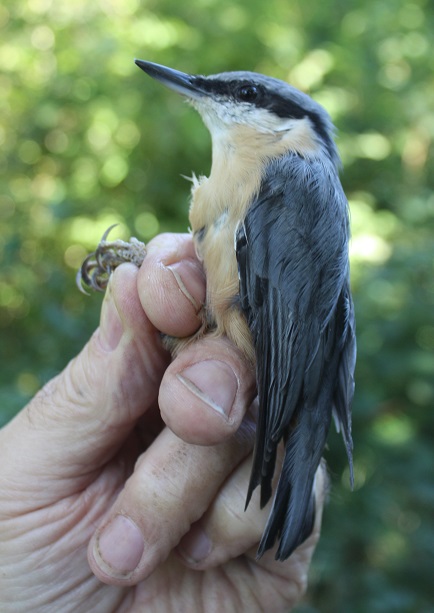Originally this session was scheduled for Friday and Saturday but I, somewhat fortuitously, didn’t feel up to the second session on Saturday and postponed it to Monday. Fortuitously because it started raining at about 9:00 on Saturday and then, soon after lunch, the monsoon arrived bringing the thunder and lightning with it. I could have been caught in that, as the session was scheduled for me to be working solo. Jonny Cooper joined me on Friday and Andrew Bray on Monday, making both sessions very easy to manage.
The list for the sessions was: Nuthatch 5; Treecreeper (1); Blue Tit 2; Great Tit 5(1); Coal Tit 3; Marsh Tit 1(2); Long-tailed Tit 2(1); Wren 5; Dunnock 2(1); Robin 13(7); Song Thrush 1; Blackbird 3(1); Blackcap 6: Chiffchaff 6(2); Goldcrest 1; Bullfinch 1.
Totals: 56 birds ringed from 15 species; 16 birds retrapped from 8 species, making 72 birds processed from 16 species. 47 of the birds processed, from 15 species, were juveniles. All of the Titmice, except for the Blue Tits, had juveniles in the catch. The lack of young Blue Tits continues to be a worrying situation: one not confined to Ravensroost. However, the situation is variable across the country, with eastern counties seeing little difference from previous years, and western counties seeing a significant decline in fledged Blue Tits. Although we have caught a few recently, and a few Long-tailed and Great Tits as well, there has been a definite reduction in breeding success this year.
The highlights of the catch were the Nuthatches. They have been calling and flying around the wood all year – but missing the nets. I don’t know why, but this time they seemed to find them. Catching five Nuthatches in the wood, without a feeding station or lure to draw them in, is very unusual.

It was very pleasing to catch another couple of this year's fledged Marsh Tit. The numbers are building up pretty well this year: already comparable with previous years, with the main catching period for them to come over the next four months. They, unlike the Blue Tits and Long-tailed Tits, seem to have had a normal breeding season. ST/JC/AB
